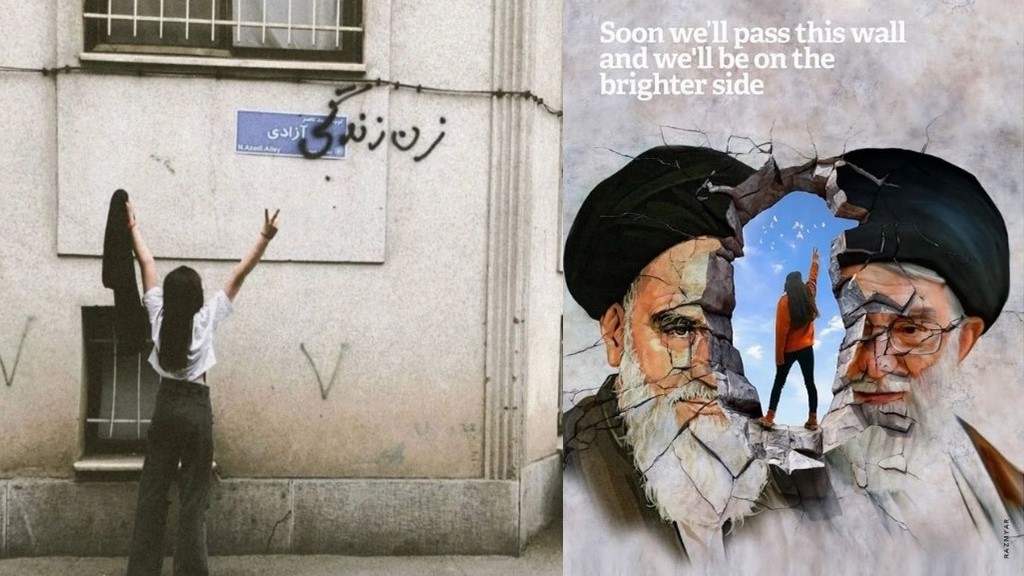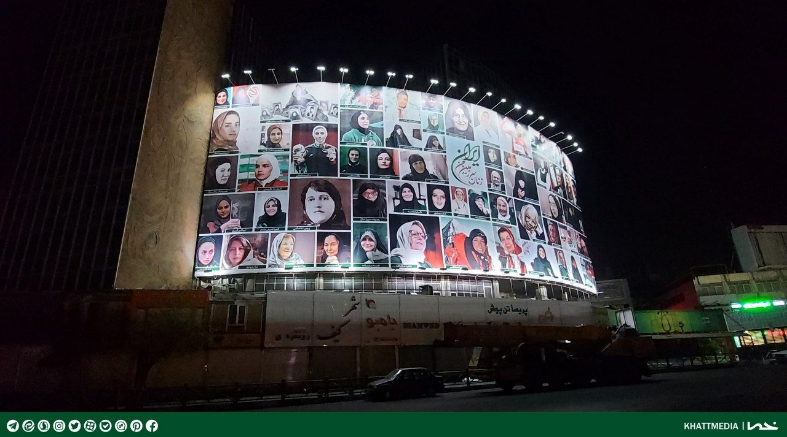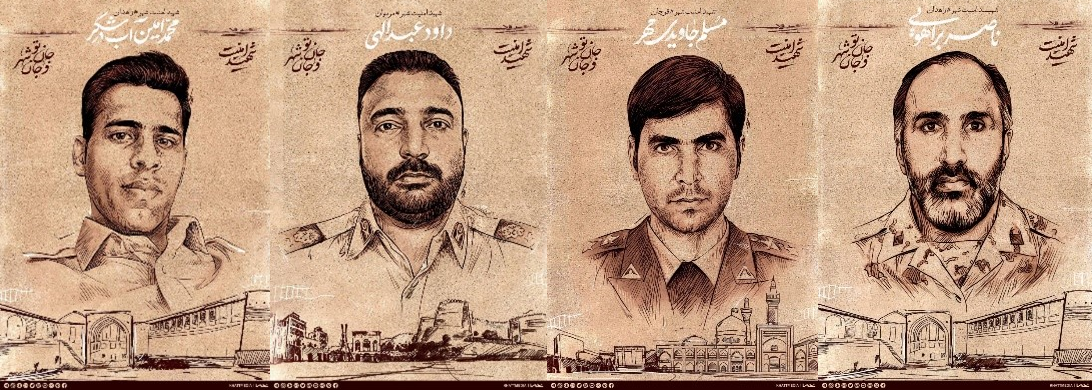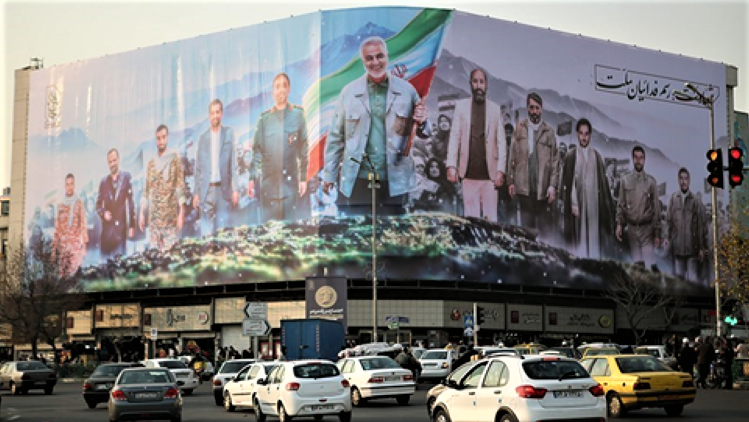What the Islamic Republic's propaganda tells us

Since protests flared up in September 2022 following the death of Jina Mahsa Amini in police custody, Iranian activists and their allies have offered up a masterclass in civil disobedience, defiance and solidarity.
The regime has been slow to respond. Despite an avowal not to be caught flat-footed in the face of oppositional media activity after the rise of the Green Movement during the contested presidential elections in 2009, it took several weeks for the typically active network of state and state-affiliated design agencies to produce any targeted messaging campaigns.
When the propaganda machine finally did get rolling, the initial focus was on well-worn tropes, such as the existence of foreign infiltration in Iranian affairs and how life in Iran under the Islamic Republic represents the best of all possible worlds. Appearing on Instagram accounts and Telegram channels of various design firms, and later circulated in the media, these initial campaigns were aimed at the online networks of hardcore regime supporters with the hope of drawing-in members of the population still on the fence about the direction of the ongoing protests.
Appealing to the lower common denominator
Campaigns like Khatt Media’s "Everything is an excuse, Iran is the target" (Hameh chiz bahaneh ast, Iran hadaf ast), released in October 2022 and promoted by IRGC-owned Owj media company, imagines the destruction of some of Iran's most important national and historical sites, including the Azadi Tower in Tehran and the tomb of the poet Hafez in Shiraz.
Featuring national and secular symbols like these, rather than those connected to the Islamic Republic, regime power, or the clerical establishment, is a common tactic in state-sponsored visual propaganda, predicated on the hope that these images will speak to a broader audience. The same firm’s "If there is no security…" (Agar amniyat na-bashad…), a phrase taken from a 2017 speech by the Supreme Leader during an army awards ceremony, plays on the same theme: if the protests continue, then destruction of Iranian society is imminent.
[embed:render:embedded:node:48361]
The series juxtaposes scenes of Iran with the destruction found in places overrun by war, like Yemen, Syria and Ukraine. The campaign is rife with masochistic irony, perhaps lost on its designers: Iran is involved militarily in these countries and thus partially to blame for their destruction. But both campaigns also point to the early struggles of regime media producers to formulate a relevant response to the protests.
Part of the reason is that, unlike the ease with which previous state-sponsored visual campaigns were willing to identify an enemy – the West, IS, sanctions, COVID-19 – this time, they were initially loath to do so. Directly identifying fellow Iranians as the enemy, despite actions on the street to the contrary, excludes a major cross-section of society that regime media producers would hope to attract. Propaganda – and the Islamic Republic is no exception – is often about winning hearts and minds.
Regime narratives ring hollow
As a result, the propaganda machine of the Islamic Republic has struggled to answer the current uprising. Just as "none of the protesters' demands can be met within the current structure [of rule]", as Iranian political activist Behareh Hedayat noted in a recent letter from Evin prison, the regime's propagandists were incapable of mounting an effective campaign against the revolutionary slogan of "Women, Life, Freedom" that strikes at the core of the Islamic Republic.
Narratives that attribute domestic problems to foreign influence, or claims that life in a "secure" Islamic Republic is always better than the alternative, ring hollow in the face of calls for less social and political control, increased women's rights and ethnic equality.
When regime media producers actually attempted to confront the slogan head-on, it proved a public relations nightmare. The mural "Women of My Country", unveiled at Iran’s Vali Asr billboard, was a pastiche of 60 notable women of modern Iran, meant to show that women can occupy an important place and succeed in the Islamic Republic….provided they wear a hijab.

Reactions were swift and devastating. Several of the depicted women (or their relatives) contested the use of their image, among them the actress Marzieh Baroumand, who wrote on Instagram "Take down my picture from the billboard under which you suppressed children and youths", and a descendant of Bibi Maryam Bakhtiari, an activist from the Constitutional Period (1906-1911), who assumed that his ancestor would be among the first to burn her hijab if she was alive today.
The billboard's operators replaced the mural a day later with nothing more than the original slogan on a white background, an ignominious defeat that proved the protesters' central charge correct: women in the Islamic Republic must be seen wearing the hijab or not seen at all.
Overly masculine symbology
The hijab is not the only symbol being contested amidst the current protests. Other symbols of the Islamic Republic, like the cleric's turban and the image of Qassem Soleimani, have become the staging ground for protesters to deconstruct the regime's overly masculine symbology, aimed at overwhelming the public square and its citizenry on a daily basis.
Passers-by knocking off the turbans of unsuspecting clerics has become one of the most widespread acts of civil disobedience. Billboards bearing the likenesses of Qassem Soleimani or Ayatollah Khomeini have been defiled, burned and smeared with red paint. It is little surprise that the visage of Soleimani, the IRGC Quds commander killed by a U.S. drone strike in 2020, should attract the ire of protesters.
For regime propagandists he is the martyr par excellence, whose life and death is viewed as encapsulating the history and struggles of the Islamic Republic, from the Iran-Iraq War and battle against IS to confronting the United States. To desecrate the image of Soleimani is to discard the history, ideology and mythmaking of the Islamic Republic in one fell swoop. When the Shah Cheragh mausoleum in the southern city of Shiraz came under attack in late October 2022, resulting in 15 deaths and scores wounded, the regime was provided with an opportunity to revamp its messaging around the protests and re-define who has the right to die (or to be seen) defending the country.
Islamic State claimed responsibility for the attack, but for many critics of the regime, it was seen as a false-flag operation, one that would allow the Islamic Republic to further justify its repression of the protests. Comparisons were made to the 1978 fire at Cinema Rex, considered a turning point in Iran's Islamic Revolution.
Iran's machinery of martyrdom production is always at the ready, but when the Islamic Republic feels especially threatened, it kicks into high gear. Regime-affiliated propagandists used the attack to roll out campaigns following long-rehearsed patterns of martyrdom and masculine myth-making.
'Martyrs of security'
The new visual campaigns would be accompanied by more severe tactics against protesters, journalists, academics and activists across the country, which were to include imprisonment, torture, executions, and sham trials. In the wake of the attack, IRGC-affiliated Khatt Media launched the campaign "Martyrs of Security" (shohada-ye amniyat), featuring men both killed at Shah Cheragh and those allegedly killed by Iranian activists during the protests.
These regime "martyrs" are promoted as guarantors of security and internal order and as the only acceptable archetypes who may be visually represented as defending the nation in moments of crisis and for all time. This radical version of militarised masculinity lies at the heart of the ideological ethos of the Islamic Republic.

The men depicted in the campaign are most certainly not the idealised martyrs of earlier eras, those innocent souls who voluntarily sacrificed themselves for the homeland, such as during the Iran-Iraq War, and in whom people trusted and supported for their sacrifice on behalf of society. These "martyrs of security" represent a masculine apparatus at once repressive in life and revered in death, the very essence of the regime that the protesters are determined to challenge, negate and ultimately overturn.
It is a campaign defined by men, death, and repression – the direct antithesis of "Women, Life, Freedom". Several months into the protests, there appears little appetite for the cursory, albeit ineffectual, attempts by regime propagandists to promote women's rights in the Islamic Republic. In fact, amidst the greatest threat to the Islamic Republic in its nearly 45 years of existence, the regime has doubled down on militarised masculinity and martyrdom myth-making.
Myth-making in overdrive
This aspect of its ideology and self-presentation has long been cultivated, but in light of the current protests, as well as other factors – such as the likely increased role for the IRGC in state and society during Ayatollah Khamenei’s twilight years and beyond – it has been put in overdrive, appearing ever more frequently in the online and offline materials of state and state-affiliated propaganda. There seems little reason to believe it will let up.
January 2023 saw the unveiling of a massive new billboard space for regime messaging on Tehran's bustling Revolution Square. Measuring 1400 square metres, the new billboard is now the largest of its kind in the capital, bigger than the Vali Asr billboard, used for regime messaging since 2015.
The Revolution Square billboard is operated by the Tehran Beautification Organisation in coordination with the Islamic Propagation Organisation (sazeman-e tablighat-e Islami) and will be used to promote national solidarity and identity during significant occasions throughout the year.

The first billboard was revealed to coincide with the third anniversary of the death of Qassem Soleimani. Appearing in front of the Iranian flag, a smiling Soleimani is flanked by 10 male martyrs of the Islamic Republic, signifying its heroes, history and struggles. The only women to be seen are mere glimpses in the background, veiled and in support of their male brethren. The message is unmistakeable. This is the Islamic Republic. Past, present, and future.
In her classic work On Revolution, Hannah Arendt contends that revolutions can only be defined in retrospect, once the old order is actually replaced and "the experience of a new beginning" is achieved. Knowing when one is in the midst of a revolution can be a tricky, if not unknowable, business. There are many reasons to believe the protests in Iran will not lead to revolution.
But as the regime doubles down on old narratives of martyrdom and masculine myth-making, in hopes of defining who has the right to be seen defending the nation and shaping its future, it has made clear the extent to which the slogan "Women, Life, Freedom" represents its antithesis.
Neither side, at least at this moment, is interested in reform, making their positions appear irreconcilable. What is being fought for – and staunchly defended against in the symbols, icons, and messages of regime propaganda – is no less than a new beginning. This in itself is revolutionary.
Kevin L. Schwartz & Olmo Goelz
© Qantara.de 2023
Kevin L. Schwartz is a research fellow and deputy director of research at the Oriental Institute, Czech Academy of Sciences, Prague, Czech Republic. Olmo Goelz is a senior lecturer in Islamic and Iranian Studies at the Department of Oriental Studies, University of Freiburg, Germany.